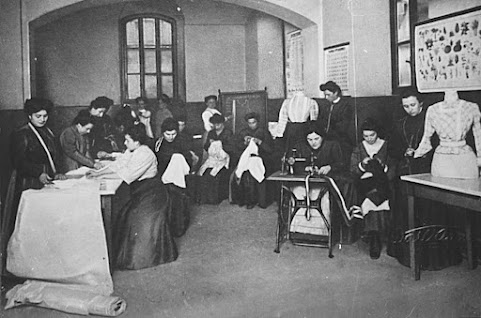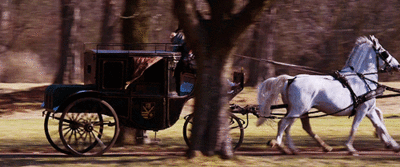Quest’oggi
vi racconto una storia che ci porta molto, molto lontano nel tempo:
con le parole torniamo nel XV secolo e sul mare, nella città
marittima di Genova, la città in cui sono nata.
Si
chiamava a quel tempo Serenissima Repubblica di Genova ed era già
ricchissima di storia e di storie da narrare; i suoi fiorenti
traffici con l’Oriente ne avevano già fatta una ricca Repubblica
Marinara, con Venezia, la più ricca e famosa di quelle italiane.
I suoi robusti vascelli ed i galeoni che solcavano incessantemente i
mari per raggiungere le terre in cui trovare spezie, seta e altri
preziosi, dovevano essere fornite di vele molto resistenti così come
dovevano essere spessi e solidi i tessuti con cui venivano coperte le
merci acquistate.
I
cantieri navali ed i mercanti genovesi usavano un tipo di cotone a
intreccio incrociato, economico, ruvido e resistente sia per
fabbricare le vele sia per proteggere le loro merci. Questo tipo di
tessuto era prodotto nella città francese di Nimes, da cui deriva il
nome "denim", ed era tessuto in combinazione con del
fustagno. A Genova tessuti simili erano tinti di blu derivato
dall'indaco scambiato con l'India. Il loro uso si estendeva anche
alla manifattura di abiti da lavoro e alle divise dei marinai e
venivano esportati con il nome francese "bleu de Gênes",
blu di Genova.
Particolarmente
apprezzato nel nord dell’Europa anche durante i secoli successivi,
raggiunse il Nuovo Continente nel XIX secolo grazie ad un
intraprendente mercante bavarese, Herr Levi Strauss: egli era partito
con la sua scorta di tela di cotone lavorata a pantaloni semplici,
senza passanti per cintura e senza tasche posteriori. Divenuto
proprietario di uno spaccio a San Francisco nel 1853, iniziò a
commerciare questi pantaloni che resistevano agli sfregamenti contro
le rocce, contro le cortecce degli alberi, alle lotte contro supporti
di legno e lunghi viaggi compiuti a dorso di muli e cavalli, anche senza sella; erano
economici e comodi e vennero presto forniti di numerose tasche
robuste come richiesto dai cercatori d’oro.
Negli
anni '60 dell'Ottocento, i pantaloni blu di Levi Strauss erano
indossati quotidianamente da minatori, agricoltori e allevatori in
tutto l'Ovest.
Nel 1873 egli comprò, per $ 69, la domanda di
brevetto, richiesta dopo che un sarto russo immigrato a Reno gli
diede l’idea di rivettare le cuciture più sottoposte a sforzi per
rendere più resistenti i pantaloni da minatore. Sono stati
soprannominati ‘blue jeans’ mutuando il nome dal francese "bleu
de Gênes".
Nel
1880 il Levi era in piena regola, con cuciture arancioni, rivetti,
tasca dell'orologio e toppa in pelle "Two Horse" per
cavalcare.
Anche
Henry David Lee legò il suo nome ai jeans, ma per altri motivi. Egli
iniziò la sua attività commerciale vendendo cherosene in Ohio e
trasferendosi quindi a Salina in Kansas, con un piccolo pacchetto di
capitale in cerca di avventura. La H. D. Lee Mercantile Company
vendeva prodotti in scatola e offriva una linea di abiti da lavoro
che provenivano dall’Oriente. Quando la merce scarseggiava e le
spedizioni tardavano ad arrivare Henry David creava i suoi capi di
abbigliamento, ovvero tute, giacche e salopette, originariamente
dette "dungarees", che presero il nome da Dungri, la tintoria di
Bombay, dove ebbero origine.
L'autista di Lee probabilmente inventò
la "Lee Union-All", una tuta di jeans che è diventata l'uniforme dei
meccanici e di altri lavoratori addetti a lavori in ambienti sporchi.
Negli
anni '20, più o meno nel periodo in cui Lee stava introducendo la
prima patta con cerniera, Levi Strauss stava eliminando il rivetto
posto all’altezza del cavallo, che durante le lunghe cavalcate
diventava fastidioso.
Ecco
che i jeans che ancora oggi vestiamo erano definitivamente 'decollati'.
Nel tempo hanno subito variazioni di conseguenza ai dettami della moda, ma per quanto riguarda l'abbigliamento sportivo sono ormai diventati un indumento classico in tutto il mondo.
E torniamo così ai giorni nostri. Come sempre mi trovo in difficoltà quando devo esprimervi i miei ringraziamenti, ancora una volta mi avete seguito fin qui con l'entusiasmo di sempre e ve ne sono immensamente grata.
Augurando ogni bene ad ognuno di voi vi do appuntamento al prossimo post
e vi abbraccio calorosamente.
A presto ❤
HEADER - Group of gravel miners photographed in 1895: each of them is wearing a pair of Levi
Strauss jeans.
Today I’m going to tell you a story that takes us back far, far away in time: with the words we return to the XVth century and let’s go the maritime city of Genoa, the city where I was born.
At that time it was called the Serenissima Republic of Genoa and was already very rich in history and stories to tell; its flourishing trade with the East had already made it rich Maritime Republic, with Venice, the richest and most famous of the Italian ones.
Its sturdy vessels and the galleons that incessantly plowed the seas to reach the lands in which to find spices, silk and other precious, had to be equipped with very resistant sails as well as the fabrics with which the purchased goods were covered had to be thick and solid.
- image 1 on the left - The Serenissima Republic of Genoa in the XVth century
The shipyards and the Genoese merchants used a type of cross-woven cotton, cheap, rough and resistant both to make the sails and to protect their goods. This type of fabric was produced in the French city of Nimes, hence the name "denim", and was woven in combination with moleskin. In Genoa, similar fabrics were dyed blue derived from the indigo exchanged with India. Their use was also extended to the manufacture of work clothes and sailors' uniforms and were exported under the French name of "bleu de Gênes", blue of Genoa. Particularly appreciated in northern Europe also during the following centuries, it reached the New Continent in the XIXth century thanks to an enterprising Bavarian merchant, Herr Levi Strauss: he departed from Europe with his stock of cotton canvas worked in simple trousers, without loops for belt and no back pockets. Having become the owner of a drugstore in San Francisco in 1853, he began trading these trousers that resisted rubbing against rocks, against the bark of trees, fighting against wooden supports and riding mules and horses, even bareback, for long journeys; they were cheap and comfortable and were soon provided with numerous sturdy pockets as required by gold seekers. In the 1860s, Levi Strauss's blue trousers were daily worn by miners, farmers and ranchers across the whole West.
- image 2 on the right - The Levi Strauss trade mark
In 1873 he bought the patent application for $ 69, which was requested after a Russian tailor immigrated to Reno gave him the idea of riveting the most strained seams to make miner's trousers more resistant. They were nicknamed 'blue jeans', taking their name from the French "bleu de Gênes".
By 1880 the Levi was full blown, with orange stitching, rivets, watch pocket and "Two Horse" leather patch for riding.
Henry David Lee also tied his name to jeans, but for other reasons. He started his business by selling kerosene in Ohio and then moving to Salina, Kansas, with a small package of capital in search of adventure. The H. D. Lee Mercantile Company sold canned goods and offered a line of workwear that hailed from the Orient. When goods were scarce and shipments were slow to arrive, Henry David created his clothing items, jackets and dungarees, called after Dungri, the dry cleaners in Bombay, where they were originated.
- image 3 on the left - The Lee Union-All
Lee's driver probably invented the Lee Union-All, a jeans
overalls
that has become the uniform of mechanics and other workers in dirty
environments.
In the 1920s, around the time Lee was
introducing the first zip fly, Levi Strauss was eliminating the rivet
placed at the height of the crotch,
which became annoying during long rides.
So
the jeans we still wear today were definitely 'taken off'.
Over
the
time
they have undergone changes as a result of the dictates of fashion,
but as a
item
of clothing
they have now become a classic sportswear
garment
all over the world.
And so let’s
come back
to the present day.
As usual I find myself in difficulty when I
have to express my thanks: once again you have followed me here with
the usual enthusiasm and I am immensely grateful to you.
Wishing
each of you all
my best,
I give you appointment at the next post and I hug
you warmly.
See you soon ❤
LINKING WITH:
BLUE MONDAY
OVER THE MOON LINK PARTY
TUESDAY'S TREASURES
INSPIRE ME TUESDAY
TUESDAY WITH A TWIST
At KATHERINE'S CORNER and at BEV'S ECLECTIC RED BARN
PINK SATURDAY























